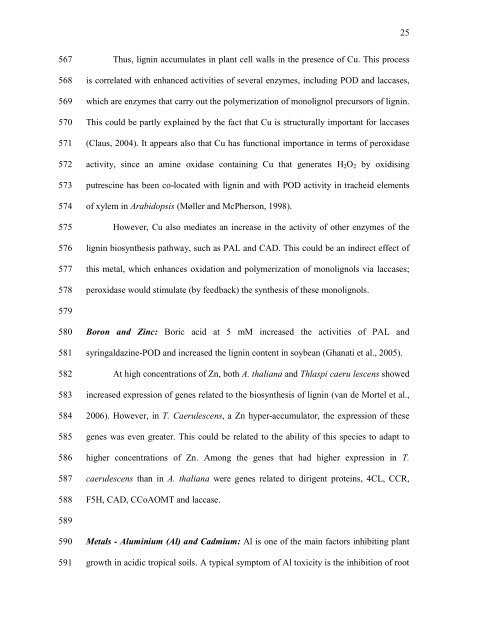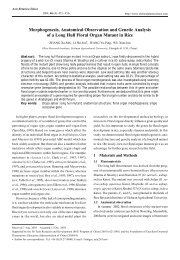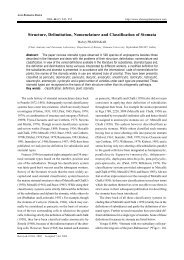Abiotic and biotic stresses and changes in the lignin ... - ResearchGate
Abiotic and biotic stresses and changes in the lignin ... - ResearchGate
Abiotic and biotic stresses and changes in the lignin ... - ResearchGate
Create successful ePaper yourself
Turn your PDF publications into a flip-book with our unique Google optimized e-Paper software.
25<br />
567<br />
568<br />
569<br />
570<br />
571<br />
572<br />
573<br />
574<br />
575<br />
576<br />
577<br />
578<br />
Thus, lign<strong>in</strong> accumulates <strong>in</strong> plant cell walls <strong>in</strong> <strong>the</strong> presence of Cu. This process<br />
is correlated with enhanced activities of several enzymes, <strong>in</strong>clud<strong>in</strong>g POD <strong>and</strong> laccases,<br />
which are enzymes that carry out <strong>the</strong> polymerization of monolignol precursors of lign<strong>in</strong>.<br />
This could be partly expla<strong>in</strong>ed by <strong>the</strong> fact that Cu is structurally important for laccases<br />
(Claus, 2004). It appears also that Cu has functional importance <strong>in</strong> terms of peroxidase<br />
activity, s<strong>in</strong>ce an am<strong>in</strong>e oxidase conta<strong>in</strong><strong>in</strong>g Cu that generates H 2 O 2 by oxidis<strong>in</strong>g<br />
putresc<strong>in</strong>e has been co-located with lign<strong>in</strong> <strong>and</strong> with POD activity <strong>in</strong> tracheid elements<br />
of xylem <strong>in</strong> Arabidopsis (Møller <strong>and</strong> McPherson, 1998).<br />
However, Cu also mediates an <strong>in</strong>crease <strong>in</strong> <strong>the</strong> activity of o<strong>the</strong>r enzymes of <strong>the</strong><br />
lign<strong>in</strong> biosyn<strong>the</strong>sis pathway, such as PAL <strong>and</strong> CAD. This could be an <strong>in</strong>direct effect of<br />
this metal, which enhances oxidation <strong>and</strong> polymerization of monolignols via laccases;<br />
peroxidase would stimulate (by feedback) <strong>the</strong> syn<strong>the</strong>sis of <strong>the</strong>se monolignols.<br />
579<br />
580<br />
581<br />
582<br />
583<br />
584<br />
585<br />
586<br />
587<br />
588<br />
Boron <strong>and</strong> Z<strong>in</strong>c: Boric acid at 5 mM <strong>in</strong>creased <strong>the</strong> activities of PAL <strong>and</strong><br />
syr<strong>in</strong>galdaz<strong>in</strong>e-POD <strong>and</strong> <strong>in</strong>creased <strong>the</strong> lign<strong>in</strong> content <strong>in</strong> soybean (Ghanati et al., 2005).<br />
At high concentrations of Zn, both A. thaliana <strong>and</strong> Thlaspi caeru lescens showed<br />
<strong>in</strong>creased expression of genes related to <strong>the</strong> biosyn<strong>the</strong>sis of lign<strong>in</strong> (van de Mortel et al.,<br />
2006). However, <strong>in</strong> T. Caerulescens, a Zn hyper-accumulator, <strong>the</strong> expression of <strong>the</strong>se<br />
genes was even greater. This could be related to <strong>the</strong> ability of this species to adapt to<br />
higher concentrations of Zn. Among <strong>the</strong> genes that had higher expression <strong>in</strong> T.<br />
caerulescens than <strong>in</strong> A. thaliana were genes related to dirigent prote<strong>in</strong>s, 4CL, CCR,<br />
F5H, CAD, CCoAOMT <strong>and</strong> laccase.<br />
589<br />
590<br />
591<br />
Metals - Alum<strong>in</strong>ium (Al) <strong>and</strong> Cadmium: Al is one of <strong>the</strong> ma<strong>in</strong> factors <strong>in</strong>hibit<strong>in</strong>g plant<br />
growth <strong>in</strong> acidic tropical soils. A typical symptom of Al toxicity is <strong>the</strong> <strong>in</strong>hibition of root







